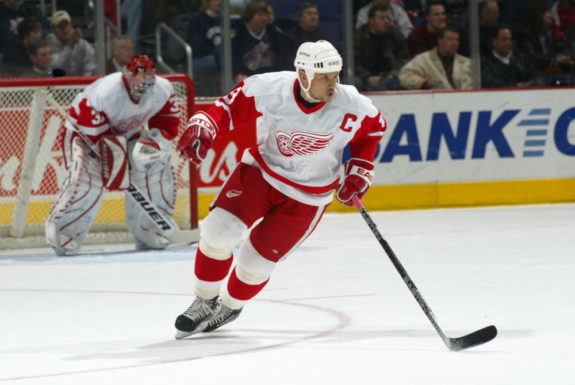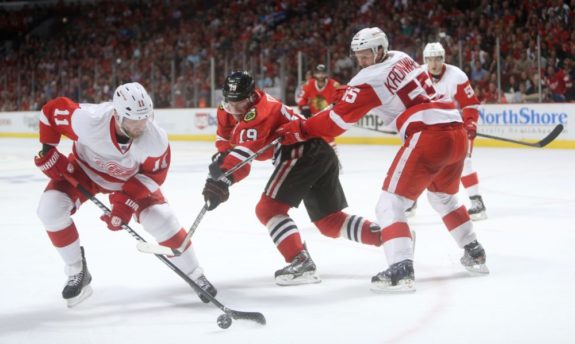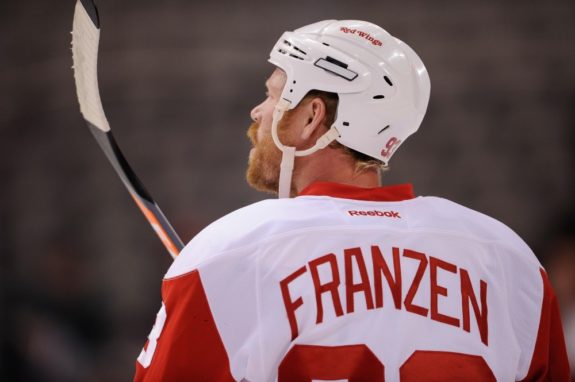Back when the NHL salary cap was first implemented, general manager Ken Holland and the Detroit Red Wings were faced with a constraint they had never dealt with before: spending limits.
In the years leading up to the 2004-05 NHL lockout, the Red Wings consistently ranked near the top in terms of team payroll. In fact, their Stanley Cup-winning 2001-02 team barely would have fit under today’s salary cap. Owner Mike Ilitch made it known that he’d be willing to open up his checkbook if it meant bringing a winner to Detroit.
But as preparations began for the 2005-06 NHL season, Ilitch wouldn’t need to break the bank – Holland could only spend $39 million at most. Detroit’s general manager had to get thrifty and forget his free-spending ways.
As today’s Red Wings struggle to stay under the cap (during their rebuilding phase), let’s look back at a less prosperous, yet more successful time in Detroit’s history. Perhaps there are a few lessons that can be applied to today’s salary cap management.
2005-06 Red Wings Salaries
Before the season began, Holland had to buy out Derian Hatcher, Darren McCarty, and Ray Whitney to become cap compliant, even with a 24% wage reduction on existing salaries. By the end of the year, here’s how Detroit’s 23-man roster and individual cap hits stood:
| Player | Pos. | Salary | % of Cap |
| Nicklas Lidstrom | D | $7,600,000 | 19.49% |
| Pavel Datsyuk | C | $3,900,000 | 10.00% |
| Robert Lang | C | $3,800,000 | 9.74% |
| Mathieu Schneider | D | $3,300,000 | 8.46% |
| Henrik Zetterberg | C | $2,400,000 | 6.15% |
| Brendan Shanahan | LW | $2,280,000 | 5.85% |
| Kris Draper | C | $2,128,000 | 5.46% |
| Kirk Maltby | LW | $1,444,000 | 3.70% |
| Tomas Holmstrom | LW | $1,368,000 | 3.51% |
| Steve Yzerman | C | $1,250,000 | 3.21% |
| Manny Legace | G | $1,162,000 | 2.98% |
| Chris Osgood | G | $900,000 | 2.31% |
| Cory Cross | D | $874,000 | 2.24% |
| Chris Chelios | D | $850,000 | 2.18% |
| Niklas Kronwall | D | $840,000 | 2.15% |
| Andreas Lilja | D | $650,000 | 1.67% |
| Johan Franzen | LW | $600,000 | 1.54% |
| Mikael Samuelsson | RW | $537,500 | 1.38% |
| Brett Lebda | D | $507,000 | 1.30% |
| Jason Woolley | D | $507,000 | 1.30% |
| Daniel Cleary | RW | $450,000 | 1.15% |
| Jason Williams | C | $450,000 | 1.15% |
| Mark Mowers | C | $450,000 | 1.15% |
Salary data provided by USA Today.
To better understand this data, we can compare salaries and production through the perspective of today’s salary cap. Keeping the percentage of salary cap consistent, here’s how these players would be paid today, with their 2005-06 point totals included.
| Player | % of Cap | 2017-18 Salary | 2005-06 GP | 2005-06 PTS |
| Nicklas Lidstrom | 19.49% | $14,615,385 | 80 | 80 |
| Pavel Datsyuk | 10.00% | $7,500,000 | 75 | 87 |
| Robert Lang | 9.74% | $7,307,692 | 72 | 62 |
| Mathieu Schneider | 8.46% | $6,346,154 | 72 | 59 |
| Henrik Zetterberg | 6.15% | $4,615,385 | 77 | 85 |
| Brendan Shanahan | 5.85% | $4,384,615 | 82 | 81 |
| Kris Draper | 5.46% | $4,092,308 | 80 | 32 |
| Kirk Maltby | 3.70% | $2,776,923 | 82 | 11 |
| Tomas Holmstrom | 3.51% | $2,630,769 | 81 | 59 |
| Steve Yzerman | 3.21% | $2,403,846 | 61 | 34 |
| Manny Legace | 2.98% | $2,236,154 | 51 | N/A |
| Chris Osgood | 2.31% | $1,730,769 | 32 | N/A |
| Cory Cross | 2.24% | $1,680,769 | 16 | 2 |
| Chris Chelios | 2.18% | $1,634,615 | 81 | 11 |
| Niklas Kronwall | 2.15% | $1,615,385 | 27 | 9 |
| Andreas Lilja | 1.67% | $1,250,000 | 82 | 15 |
| Johan Franzen | 1.54% | $1,153,846 | 80 | 16 |
| Mikael Samuelsson | 1.38% | $1,033,654 | 71 | 45 |
| Brett Lebda | 1.30% | $975,000 | 46 | 12 |
| Jason Woolley | 1.30% | $975,000 | 53 | 19 |
| Daniel Cleary | 1.15% | $865,385 | 77 | 15 |
| Jason Williams | 1.15% | $865,385 | 80 | 58 |
| Mark Mowers | 1.15% | $865,385 | 46 | 15 |
Lessons Learned
With the context of how the 2005-06 salaries and contracts would look under today’s salary cap, there are a few notable storylines that can be pulled from the data and lessons that can guide general managers’ decisions 12 years later.
Don’t Overpay Veterans
While every free agent class and negotiation period has its own idiosyncrasies, general managers should do everything they can to avoid signing a veteran player to a burdensome contract. In 2005, Holland bought out three examples of these sorts of contracts to get under the salary cap. Hatcher, McCarty and Whitney were going to be paid more than they were worth and were rightfully bought out.

In addition, a few veterans on the final roster were held onto because of team-friendly contracts. Chris Chelios and Steve Yzerman re-signed prior to the 2005-06 season at a pay grade closer to their production levels, rather than what they achieved in the past. In fact, Chelios and Yzerman took major pay cuts compared to their 2003-04 salaries, when they each pulled in a shade under $6 million for that season.
Search Through the Bargain Bin
Like the Red Wings recently did with Thomas Vanek, they signed a few low-risk, high-reward free agents to cost-effective contracts prior to the 2005-06 campaign. Daniel Cleary, Chris Osgood and Mikael Samuelsson were all brought in for cheap depth and became integral parts of the organization. All three were part of the 2008 Stanley Cup team and Cleary remains with the Red Wings today in a front office role.

If there is an open roster spot, there’s nothing wrong with signing a player of this nature to a low-cost, one-year deal. If the player pans out, then the team either has depth for a playoff run or a trade chip at the trade deadline. If the player does not perform well, then he can be buried in the AHL with such a low-paying contract.
Tampa Bay’s Yanni Gourde is a perfect example of a player/contract like this. And he’ll likely be playing a vital role for Yzerman’s Lightning in the playoffs this year.
Mix In Entry-Level Players
They’re cheap. They’re eager to play. Why not include a few entry-level players on the 23-man roster? Especially when you’re up against the salary cap upper limit, general managers should give young players a long look when finalizing the roster.

Back in 2005, Holland’s team included Johan Franzen, Brett Lebda, and Jason Williams, with each making near the league minimum. That team also featured cameos from Valtteri Filppula, Jimmy Howard, Jiri Hudler, Tomas Kopecky, and Kyle Quincey. While the Red Wings added a few bargain veterans for depth, they also gave these young players a fair shot to stick with the team.
Final Word
When you combine the low-costing veterans, bargain signings, and entry-level players with a core of adequately paid stars, you have the potential to have a high-performing team. The 2005-06 Red Wings were just that – until the playoffs. However, their regular season success should be noted – they scored the second-most goals in the NHL that season (304) and finished with the best overall record (58-16-8, 124 points).
Related – The Grind Line: Where Will Mike Green Land?
Perhaps today’s Red Wings can learn from their history and build a team in a similar fashion. They’ll need to do some prep work—just as Holland did back in 2005—and shed some ugly long-term contracts first.